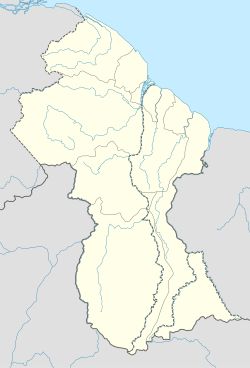|
Baracara
Baracara village was founded by people of African descent in the East Berbice-Corentyne Region of Guyana, located on the Canje River. The community has also been called New Ground Village[2] or Wel te Vreeden. Baracara is 20 miles west of Corriverton and just north of the Torani Canal's connection to the Canje River. OverviewBaracara is the only maroon village in Guyana.[3][4] A group of escaped slaves settled in Baracara in the early 19th century,[3] and occupied both the east and west banks of the river. The demographics are mostly Afro-Guyanese.[5] The economy of the village is based on subsistence farming and logging. The village has a health centre, and a primary school, but no secondary school.[2] Baracara can be only accessed by boat from the river.[2] As of 2015, the village has no local government.[6] In 2018, the village received access to the telephone network and Internet.[1] The village has Scottish Presbyterian, Adventist and Pentecostal churches.[5] Maroonage in GuyanaUnlike neighbouring Suriname where tribes like the Ndyuka and Saramaka established autonomous territories, escaped slaves in Guyana were hunted by the local Amerindian tribes for reward.[7] The incentive was very successful: on 5 May 1764, after the Berbice slave uprising, the post holder at Courantyne, near present-day Orealla, reported that he had paid out ƒ 1,074 for captured slaves, and ƒ 1,080 for 180 cut-off hands of killed slaves.[8] In 1740, Thomas Hildebrand was given permission to look for silver in the Blue Mountains using slaves. The hard work and rough treatment resulted in six deaths among the slaves.[9] The next year, a group of mining slaves escaped to Creole Island on the Cuyuni River. The location was too difficult to conquer, therefore a deal was negotiated[10] and concluded on 8 February 1742.[11] The slaves would be freed, and never had to work in the mines, if they promised to perform a fixed amount of work on the plantations.[10] Three slaves who did not accept the offer were hunted and killed by the local Amerindians.[11] Notable residents
References
Bibliography
|
||||||||||||||||||||
